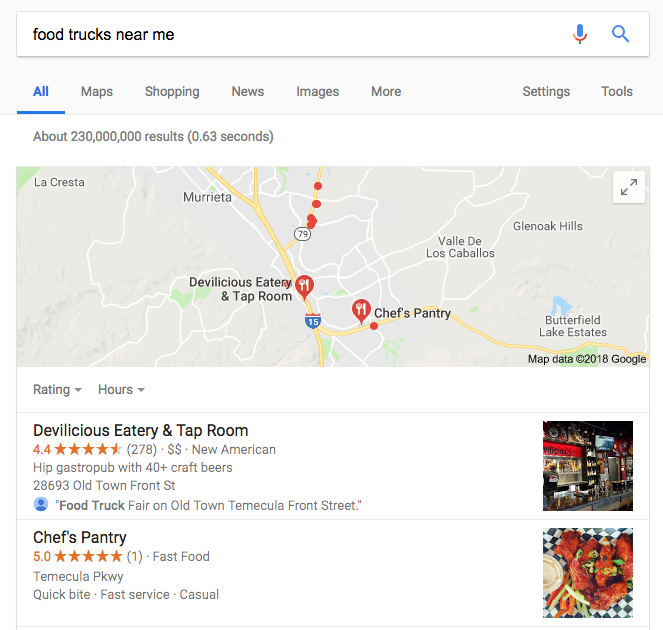Want to market your food truck on on major search engines like Google and Bing? Getting the major search engines to pay attention to your mobile food business is one of the easiest ways to generate new customers in addition to capturing lucrative catering opportunities that can really benefit the bottom line.
In order to get Google to take notice of your business, you’ll need to complete a little basic SEO or search-engine optimization. In layman’s terms, SEO is all about ensuring search engines find and display you prominently within results pages. You can get technical with it, but for this guide we want to give you a straight-forward trade manual you can use to improve the overall marketing of your business.
Many of the advice in this simple guide is requires minimal technical prowess or specialized knowledge. For the most part, all you need to do is set it up and enjoy the benefits.
Create a Google My Business Account
If you only take away a single tip from this guide… Do this one thing. Setup a Google My Business Account. If you’ve ever seen a bunch of listings in a map in the search results of Google like the image below, you’re seeing Google My Business listings displayed. If you don’t register for one of these free and easy to create accounts then you won’t be listed here. Instead one of your competitors will likely be displayed that is wiling to invest 30 minutes of personal time.

The process for registering a food truck on Google My Business is easy. Be as complete as possible when it comes to filling out your profile during the registration process. Questions that will be asked include asking your business name, telephone number, business address (you can note that you travel to customers by selecting a check box), and include a short description what your business does and a link to your official website or social media profile. After entering this information Google will verify your business account by phone call or postcard to ensure you’re a real person.
Although you aren’t required to add photos or video to a Google My Business listing you should to maximize the benefits of this tool. Google states that profiles that include more photos get more views than businesses without them. Plus in 2018 it’s really easy to get high-quality photos at no cost by using your phone. You can view a full list of image types that be added to Google My Business here.
As a food vendor, adding compelling photos to Google is really simple. Some good photo opportunities of your truck serving at an event is a quality option. Other opportunities are to take photographs of your food after it’s plated. Finally, be sure to take some action shots of food being created along with you and the staffs friendly faces. Customers like to see the people behind their favorite food trucks.
Finally, after your Google My Business profile is complete, be sure to encourage customers to leave honest reviews for your business on Google. Getting between 20 – 30 reviews for your business on Google will put you ahead of 95% of the competition in your area and help you secure more business.
Related Reading: Check out our post on marketing your food truck using social media platforms like Facebook and Twitter.

A clear cab highlights the mobile kitchen interior of Triple J’s Pizzeria.
Optimize Your Website
After you’ve setup your Google My Business profile, the next step is to optimize your website for search. This section will only apply if you own a branded domain name like MR-Trailers.com for example. If you plan to use a Facebook page for the food trucks web presence you can skip this step.
In the spirit of keeping things simple, the goal of this step is the let search engines know what you are. In this case, you are a food truck that operates in a certain city.
Make sure to include the following type of statement within the text area of your homepage: Bob’s Rolling Pretzel Shop is a Food Truck Serving the Miami Area.
This type of a statement helps search engines to understand what you are and where you serve customers. This basic statement should be included in the text area, title tag, and meta description fields of the website if you have access to all of them.
Another best practice is to include your telephone number, the name of your truck, and other contact information clearly on your website. This makes it easy for customers to get in contact you with catering opportunities or questions. Don’t make finding your contact information difficult!
Take Advantage of PR Opportunities
Without getting too far into the weeds, one way Google and other search engines algorithmically decide what results to show is by checking where are business has been referenced online. For example, if your food truck was quoted in a online news report about a fundraiser you participated in… This type of online reference would help your businesses placement in search.
Google views references or links to your food truck business sort of like a vote for your business and site. The more votes you get, the stronger signs of validation for search engines. Aside from press, other ways to further validate your business is to register with popular review websites like Yelp.
In conclusion, you could spend years mastering SEO for food trucks but as an operator you won’t have time. Fortunately, if you follow the advise outlined in this post, you’ll better positioned to compete in search compared to most other food vendors.
